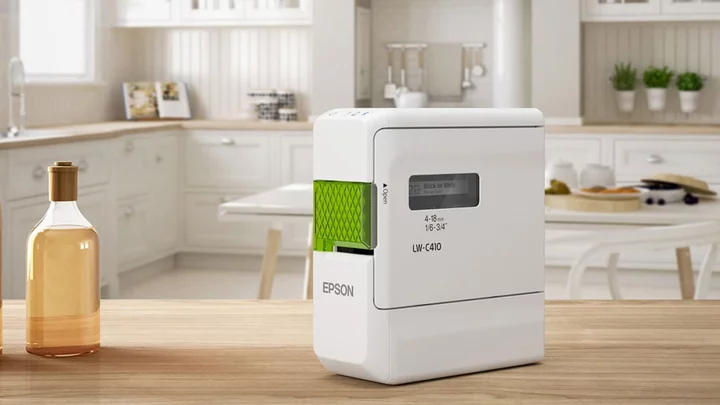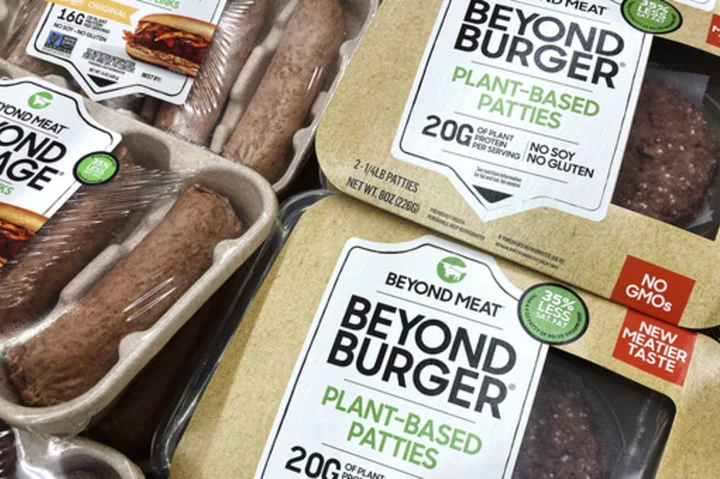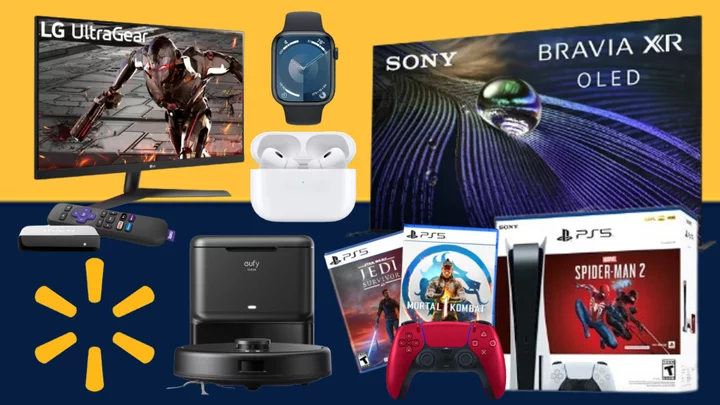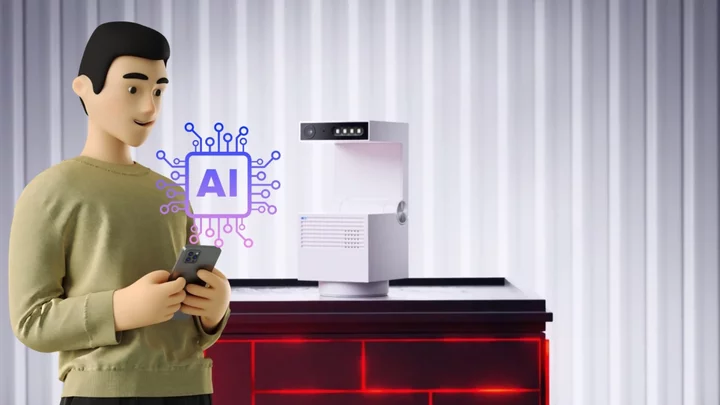Although Epson calls the Epson LabelWorks LW-C410PX ($59) a home label printer, it has a lot in common with the LW-PX300, which Epson lists as a work printer and is our current Editors' Choice pick for hobbyists as well as small businesses who need light-duty printing of plastic (and similar) labels. Both handle label tapes up to 0.71 inch wide, both have similarly slow speeds, and Epson offers a nearly identical assortment of tape types, colors, and sizes for both. They even share the same list price. The key difference? The LW-PX300 is a strictly standalone printer with its own keyboard, while the LW-C410PX prints strictly from a mobile device or Windows PC via Bluetooth. The best fit will depend largely on which approach you prefer for printing.
The Design: BYOB (Bring Your Own Batteries)
The LW-C410PX is a stylish off-white box, with cut corners plus rounded and beveled edges to make it look a lot more appealing. It weighs 0.9 pound, measures 5.7 by 2.1 by 5.6 inches (HWD), and adds a near-square inlay of translucent green plastic above the front output slot to further enhance its visual appeal. The left side includes a door that opens to let you load or remove a tape cartridge, while the bottom has an easily removable cover for the battery compartment. The power button and status lights are on the top, near the front edge.
Thanks to its light weight and its battery power, you can take LW-C410PX with you anywhere and connect from a phone, tablet, or Windows PC (but not a Mac) by Bluetooth to print. However, the printer offers no other way to connect, and—potentially more important—no option for using AC power. The printer automatically powers down after 20 minutes if you forget to turn it off, but you can still go through a lot of batteries over its lifetime, which can be as long as you like, since it's covered by a lifetime warranty. If you need portability only occasionally, or have no need for it at all, you'll probably be better off with a printer like the LW-PX300, which can use batteries or AC power, as appropriate.
(Credit: Epson)Setup is easy. Load the batteries, insert the supplied cartridge, download the label app to your PC or mobile device, and connect by Bluetooth. Batteries aren't included, so be sure you have six AA batteries on hand to get started.
The Consumables: New Tapes for Home Users
When Epson introduced the LW-C410PX (along with the LW-C610PX, which I'll be reviewing shortly) it also created a new home label printer category on its website and added new choices for tape cartridges. Some, including printable ribbons, are of special interest for scrapbooking, crafting, and home DIY projects. Others are the same as or similar to types that Epson already offers, but at shorter lengths, lower prices, and an expanded choice of colors. The seven new types are designer matte, pearlized and special color, metallic, gold imprint, printable ribbon, fluorescent, and soft color. For the widths that the LW-C410PX can accept, the total number of choices for the new tapes is 46, with each category offering two to 18 width and color combinations.
In addition, the LW-C410PX can use essentially the same selection of cartridges Epson lists for work use for the LW-PX300. That total comes out to 86 additional choices in seven categories: standard industrial plastic tapes, matte tapes, strong adhesive, removable adhesive, shrink tube (for cables), magnetic (similar to refrigerator magnets), and fluorescent (in different tape lengths than the home category). And note that the LW-PX300 can use the new set of home supplies as well, which didn't exist when we reviewed it.
(Credit: Epson)Aside from differences in types and color combinations among the home and work cartridges, the two categories also have differences in tape length and price. Both factors vary from one tape type to another, but the majority of tapes in the work category come in 30-foot rolls and at this writing cost $22.10 or $26.34, depending on their width. The majority in the home category come in 26-foot rolls and are $15. That works out to 6.1 or 7.3 cents per inch for the majority of work tape types and 4.8 cents per inch for most home types. All are continuous rolls, so the cost per label will vary depending on the label length.
Testing the Epson LabelWorks LW-C410PX: Bluetooth Blues
The problem with a printer that connects only by Bluetooth is that if your PC doesn't include Bluetooth (as with some desktops), you can't print from it. The good news is that thanks to Epson's mobile printer app, you can create labels and print them from virtually any Android or iOS phone or tablet or any Windows PC with Bluetooth. (Epson doesn't provide an app for macOS.)
For printing from a PC, Epson's Label Editor (version 2.11) is one of the more capable labeling programs available. And if you prefer full-size keyboards to touch screens, it will probably be your preferred choice. However, I suspect most people will use their phone or tablet for printing, using Epson's Label Editor Mobile (version 1.1.0). I found it reasonably easy to use, with a solid set of editing features, include the ability to add images (from your phone's gallery for example), a wide variety of symbols (line drawings ranging from headphones and USB memory keys to a slice of pizza), shapes (squares, rectangles, lines), bar codes, QR codes, and more. The app also has an insert image feature, which sometimes worked as promised in my tests, but sometimes took several tries to work. Epson said it hasn't seen this problem before, and is currently looking into it.
(Credit: Epson)Creating and printing labels was generally easy enough, but the process could be improved. For example, the printable ribbon cartridge has an easy-to-miss warning telling you to use scissors to cut the ribbon. If you don't notice it—or even if you do notice, but forget to turn off the cutter—you can run into problems with ragged cuts, partial cuts, or jamming the ribbon and ruining the cartridge.
The printable ribbon also lacks a warning that you have to add an extra inch to the label size for the ribbon to advance enough to use scissors without first removing the cartridge from the printer. Both of these issues should be covered in an instruction sheet that comes with the ribbon. Even better would be for the printer to recognize when it's using a ribbon cartridge and both turn off the cutter and add the extra length automatically. It would be a natural extension to the already-existing command to check the cartridge to automatically set the label size to the proper width. Epson says it is aware of this issue and is looking into the possibility of adding the feature, which may require upgraded versions of the cartridges, a potential printer firmware update, or both.
(Credit: Epson)Because our standard printer testbed PCs don't support Bluetooth, I ran all of my tests, including the performance tests, from my Samsung Galaxy S20 FE phone. Epson rates the LW-C410PX at 0.35 inches per second (ips). That's a bit faster than the LW-PX300's 0.24ips, and notably slower than more-expensive printers meant for a little heavier-duty printing, like the Epson LW-PX400, one of our top picks for printing using up to 0.94-inch-wide tapes.
In our tests, the LW-C410PX was the slowest of the three models, probably in part because of the Bluetooth connection. For a single label, and not including cutting time, it averaged 0.20ips, which translates to about 5 seconds per inch. It also came in at 0.20ips for a set of 10 labels including automatic cutting after each, which means the actual print time is faster, but the throughput time is slowed down by how long it takes to send the data to the printer plus the time for cutting the 10 labels. For comparison, the LW-PX300 came it at 0.23ips for a single label, and the LW-PX400 came in at 0.27ips. For multiple labels with auto cutting, the LW-PX400 showed off its faster speed, at 0.48ips. (The LW-PX300 has a manual cutter, so couldn't run this test.)
(Credit: Epson)As with most label printers, output quality is more than acceptable. The 180dpi resolution, which is typical for the price, delivered crisp, sharp edges in my tests along with highly readable text.
Verdict: Best for Portable Label Printing From Phones or Tablets
The LW-C410PX can be an attractive choice for light-duty label printing if you need a strictly battery-powered printer and you also prefer using a phone, tablet, or laptop to create labels rather than using built-in features in the printer itself. That said, if you'd rather use AC power at least occasionally, consider the LW-PX300 or the LW-PX400. Both can use either batteries or AC power and can also use both Epson's label cartridges aimed at home use and the ones that are labeled for work. The LW-PX300 is the only one of the group that's a standalone printer, with a built-in keyboard and firmware for options that include adjusting font size and adding a frame, bar code, or symbol. The more-expensive LW-PX400 is similar to the LW-C410PX in size, shape, and lack of standalone printing, but it can print on wider tapes, it's the fastest in this group, and it scan also connect to and print from a PC using your choice of USB or Bluetooth.









